2016 Mid-Size Truck Shootout – Toyota Tacoma, GMC Canyon, Nissan Frontier
2016 Mid-Size Truck Shootout Cont.
Engine Performance, Speed
Give me fuel
Give me fire
Give me that which I desire
“Fuel” - Metallica
For 2015, the all-new Colorado offered the lone new engine in our Mid-Size Shootout, but in 2016 we actually have two all-new engines: the Canyon’s 2.8L Duramax turbo-diesel and the Toyota’s new 3.5L Atkinson cycle V6.
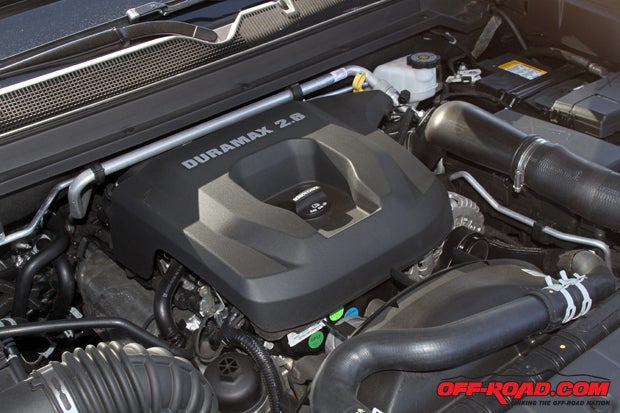
The Canyon’s Duramax offers mid-size truck buyers an intriguing proposition. Used extensively overseas, it puzzles us as to why it took so long for us to get a similar setup in the U.S. It could be emission regulations, higher costs associated, a larger sticker price… maybe it’s all of these things, but GM was the first to make the move with its new turbo-diesel in its GMC Canyon and Chevrolet Colorado.
How They Stack Up
Toyota Tacoma 4.0L V6 (6-speed auto)
278 hp @ 6000 rpm
265 lb.-ft. @ 4000 rpm
Nissan Frontier 4.0L V6 (5-speed auto)
261 hp @ 5600 rpm
281 lb.-ft. @ 4000 rpm
GMC Canyon 2.8L Duramax Diesel (6-speed auto)
181 hp @ 3400 rpm
369 lb.-ft. @ 2000 rpm
On paper, the Duramax engine looks like it should perform well in this category, and in the real world we have to say that it fulfills our expectations. Back when we had our first impression of the 2.8L Duramax we were pleased with its overall performance, and after spending even more time in the truck our initial take is reinforced.
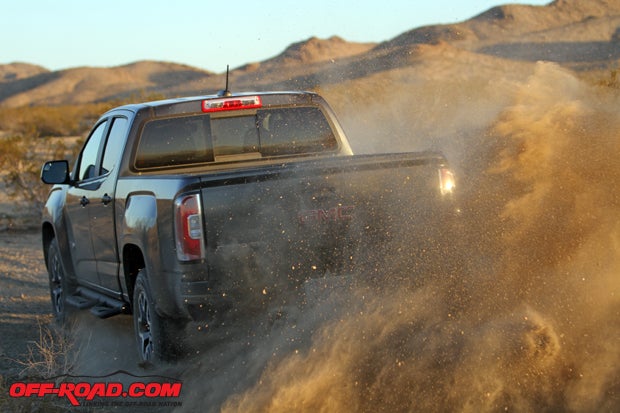
The GMC jumps out of the hole pretty hard under full throttle. Considering peak torque is made at 2,000 rpm, the diesel gets to the sweet spot quickly and simply keeps on pulling until it simply runs out of lunge once it passes 3000 rpm or so. The truck doesn't nose over, but it simply doesn't pull with the same authority unladen, which isn’t a big surprise considering turbo-diesels tend to work better under load. The Duramax, at 369 lb.-ft., offers 100 more lb.-ft. of torque compared to the 3.6-liter gasoline engine from GM, and we tend to like the overall power delivery of the diesel more. In fact, we universally liked the Duramax engine the best during testing for its great power-to-ground pull whether on the trail or the highway.
We were a little surprised to see the 0-60 time of the Canyon being the slowest at 10.10 seconds because it simply doesn’t feel slow compared to its competition. On the other hand, the Canyon came in with the most impressive fuel economy – and it wasn’t even close – with a combined city/highway rating of 28.6 miles per gallon.
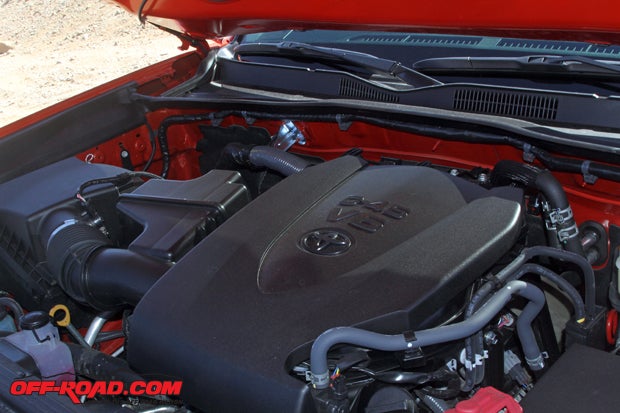
The Tacoma has a new engine after a long run with its outgoing 4.0L V6. Toyota engineers crafted a new 3.5-liter V6 engine that features dual variable valve timing, which Toyota calls VVT-i, or variable valve timing with intelligence since it’s an updated version of its earlier VVT technology. This new engine also is tagged as being an Atkinson Cycle, though that’s only partially correct. The Tacoma engine doesn’t operate like a traditional Atkinson Cycle engine found in many hybrids; this V6 actually cycles between a traditional Otto Cycle and then operates on the more efficient Atkinson Cycle when the engine is not under heavy load (like when you’re at a cruising speed).
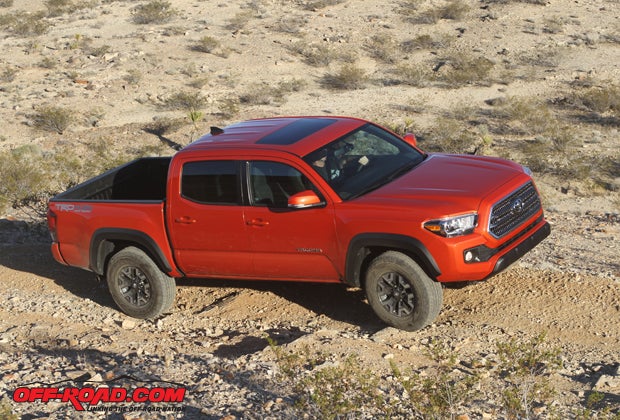
To break the 3.5L down in simpler terms: the end result is that it feels like the outgoing 4.0L. The seat-of-the-pants feel is similar for the most part, though the new engine provides 42 more horsepower and it loses 1 lb.-ft. of torque. Gearing is a little steeper on the new Tacoma at 3.90:1, and its 265 lb.-ft. of peak torque is made at 4,600 rpm – or more than double the Duramax.
0-60 Times
Nissan Frontier PRO-4X: 9.15 seconds
Toyota Tacoma TRD Off-Road: 9.27 seconds
GMC Canyon All Terrain Z71: 10.10 seconds
The steeper gearing and additional horsepower give the Tacoma a nice hit off the bottom, and up through the mid-range there’s plenty of power and the truck really likes to run. The Tacoma finds itself right in the hunt for fastest 0-60 time but falls just short of the Frontier at 9.27 seconds. In comparing the gear ratio of the Frontier (3.42) and the Tacoma (3.90) it’s clear the new Tacoma V6’s additional horsepower keeps it in step for acceleration and power in spite of its added gear.
Overall, the performance output of the new engine is good. If you ever drove the previous-generation Tacoma you likely won’t notice a big difference. Like the Canyon, the Tacoma also features a six-speed transmission. Toyota engineers also managed to scrub off 12 percent of aerodynamic drag on this new truck compared to the previous generation. During testing, we averaged a combined city/highway figure of 20.3 miles per gallon (mind you, this doesn’t include off-road testing, since it would completely skew the numbers).
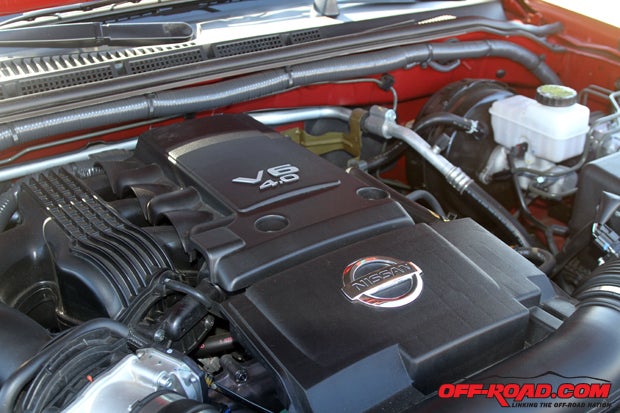
The Nissan Frontier, the lone five-speed automatic transmission holdout, was the quickest of the bunch in the 0-60 testing at 9.15 seconds. The 4.0-liter DOHC 24-valve V6 is rated to produce 261 hp in the same range as the Toyota at 5,600 rpm. Its peak torque, however, is both greater at 281 lb.-ft. and reached at a lower rpm than the Tacoma at 4,000 rpm. The overall performance of the Nissan’s V6 make it great for everyday driving situations, and it is enjoyable to drive in pretty much every condition.
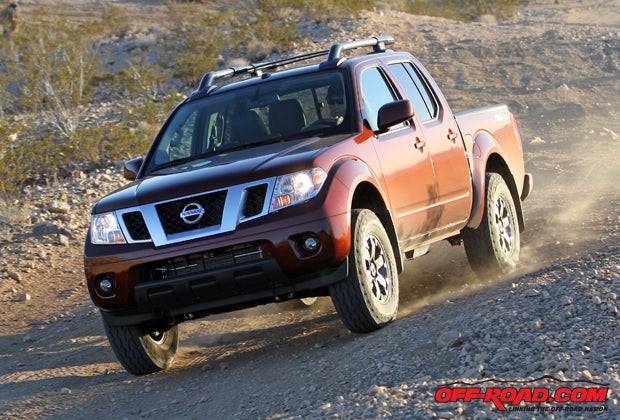
What the Frontier’s engine lacks in refinement it makes up for in familiarity, as the truck’s power delivery feels the most gruff and truck-like overall. Our take is that's simply because the other two manufacturers have modernized their engine and transmission packages more, but the Frontier harkens back to a simpler time in the development of trucks when everything wasn’t digitized, LED’d and touch-screened. Then again, the lack of refinement with the Frontier’s 4.0L also comes into play with fuel economy, as it was the least efficient during testing at 18.3 mpg combined.
Comparing our data to last year, the gas trucks are in step in terms of how close they are, although both are about a half a second slower – which we are confident was simply be due to being tested in slightly different conditions than the 2015s.


 Your Privacy Choices
Your Privacy Choices